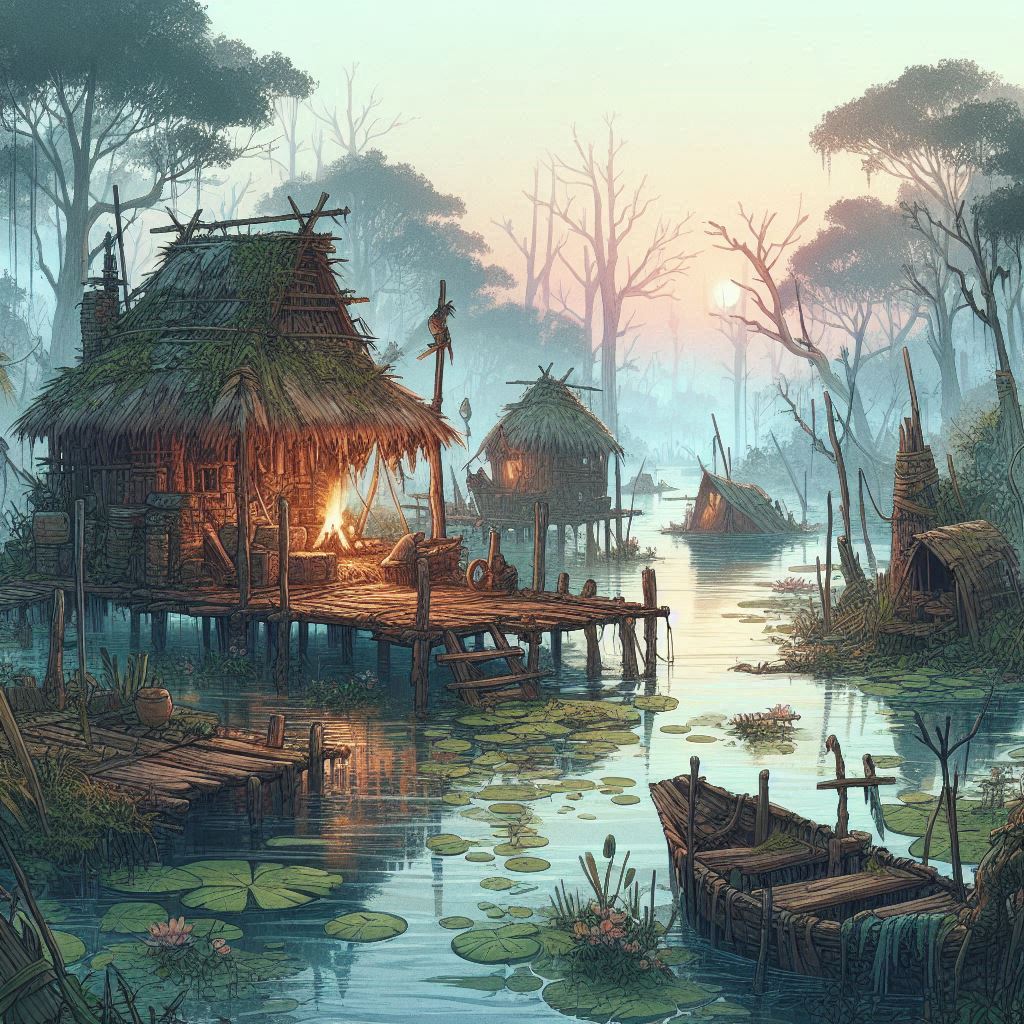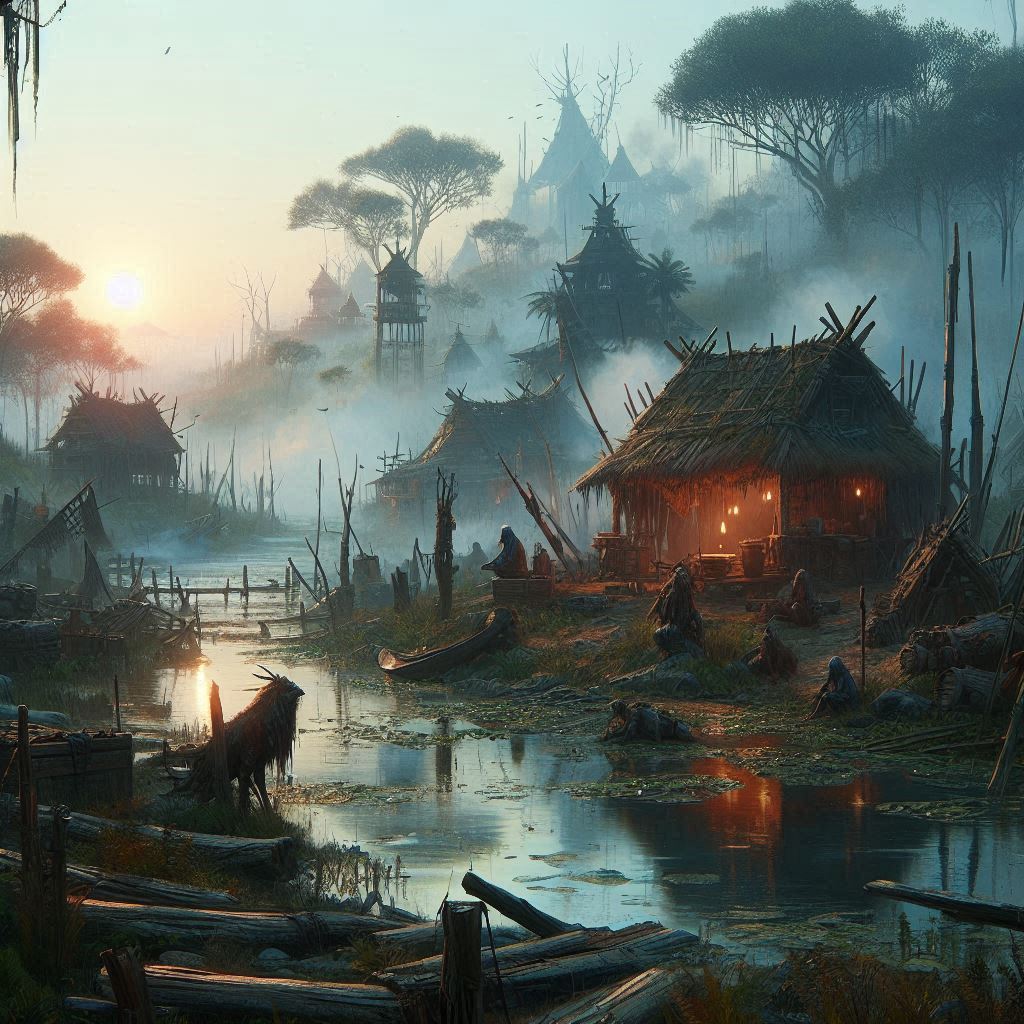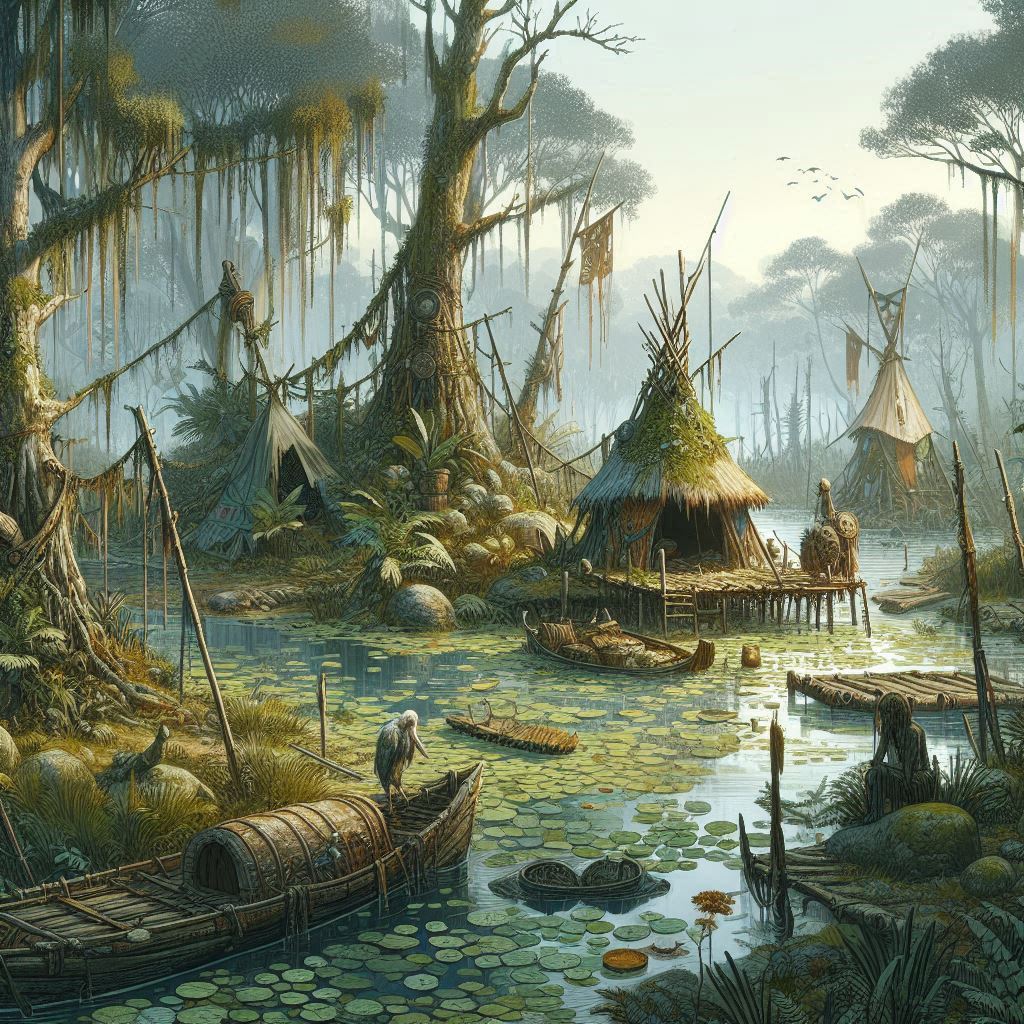Swamp culture
SKILLS
- Ambush
- Boat Pilot
- Butchery
- Camouflage
- Climbing
- Detect Traps
- Direction Sense
- Fishing
- Fletching
- Foraging
- Hunting
- Jumping
- Leatherworking
- Read Tracks
- Rope Mastery
- Rowing
- Set Traps
- Slings
- Sprinting
- Stalk & Hide
- Stilt Walking
- Swimming
- Tracking
- Trap Building
- Woodworking
Legend
“From algae ponds and thick, dense foliage, the mightiest of heroes have emerged.”
Description

This group traditionally lives in the swamps and bogs of lowland, hilly, and highland areas alike. Swampers are often seen as mysterious and reclusive. They are deeply connected to the wetland environment, possessing profound knowledge of its secrets and its treacherous terrain. They are skilled hunters, fishermen, gatherers, and craftsmen.
Lifestyle: They live in extended families in villages and fortified clan-holds, working as hunters, farmers, smiths, craftsmen, brilliant poets, singers, and storytellers.
Diet: Swamp dwellers have a diet that includes fish, amphibians, and a variety of plants that grow in wet environments, such as cattails, water chestnuts, and certain fungi. They may also eat game animals adapted to swampy areas. Their diet is often rich in unique flavours but can be limited by the difficulty of agriculture in such environments.
Traditions and Stories: Folklore, myths, and stories abound, frequently involving swamp animals and old shamans. Stories of mythical heroes who tamed the untamed swamps and gave wealth to their communities. Celebrations of the changing seasons that include music, dancing, and sacrifices to satisfy swamp spirits.
Marriage Pattern: Marriages are commonly used to strengthen clan relations. Marriages include rites to honour swamp deities and spirits, which are frequently celebrated in sacred groves or near ancient trees.
Religion: The clergy are both revered and feared, and they play an important role in preserving spiritual balance. They worship a complex pantheon of deities, many of which are based on peculiar interpretations of the “true gods.” Frequent sacrifices and ceremonies to please the swamp’s spirits and deities.
- Religious system: Nature worship of the connection to the natural world, with deities representing elements, plants, and animals.
- God-Mortal Interaction: Honour for those who have adapted to the swamp’s challenges and deities associated with swamps, rivers, and the creatures that inhabit them.
- Rituals: Ceremonies to appease swamp spirits, harvest festivals, and rites of passage involving water-based trials.
- Impact on Society: A strong sense of community and interdependence. Respect for the natural world is paramount. Religion reinforces the importance of survival skills and knowledge.
Skjald Kazumix
Craftsmanship: They are skilled in making complicated objects out of swamp materials like reeds, rushes, and other plants, as well as bronze, copper, tin, leather, yarn, and wood. To make common objects such as baskets, mats, and even garments. Their intricate patterns sometimes include themes of swamp flora and animals, such as vines, frogs, and water lilies.
Clothing & Decoration: They create useful clothing, including wool and hide tunics with leggings and tough overcoats, short cloaks, and plant-based products. Natural elements such as feathers, bones, and stones are used to create jewellery and decorations. Clothing frequently includes symbols and patterns representing the wearer’s family and clan.
Armor:Typically none or light armour made from leather or woven plant materials.
Weapons: Blowpipe, spear, sword, club, dagger, handaxe, javelin, bow, cudgel, dart, net.
Special Items: Elaborate workmanship with rustic appeal, often using materials like bronze, copper, tin, leather, yarn, and wood.
Skjald Valgrif
Time: Swamper cultures follow seasonal flooding, animal behaviours, amphibian mating sounds, and moon phases.
Accomplishment and achievement: Surviving treacherous terrain, knowing how to traverse and flourish in the swamp, having herbal knowledge, and maintaining harmony with swamp spirits are all important.
Authority Interaction: Leaders who guide their people and emphasise balance are often bog queens, shamans, healers, elders, or druidic circles, known for their extensive understanding of swamp secrets and dangers.
Fears & Inabilities: Beliefs in malicious spirits have led to a notable fear of darkness. Some discomfort in strong sunshine; prefer the swamp’s shady, wet habitat.
Mien: Culture has a medium influences on demeanor, but individual personality is still evident.
Mannerism: Challenging environment might result in a patient, resourceful demeanor.
Prejudices: They have a general distrust of nomads, with some unease towards Urbans.
Skjald El Mary
General Resistance: Moderate.
Disease Resistance: Moderate due to exposure to waterborne diseases and reliance on close-knit communities.
Poison Resistance: Moderate, with a deep familiarity with local toxins and antidotes.
Remedies: They make considerable use of medicinal herbs and natural treatments found in wetlands.
Skjald Sejrik
History

Swamper cultures often have a history of isolation, leading to the development of unique traditions and beliefs. They have tales of ancient, powerful swamp creatures and shamans who wielded great power and wisdom.
Skjald El Mary
Cartography

Swampers live in the lowlands, hills, and highlands, in villages built on stilts or floating platforms to adapt to the wetland environment. Their maps detail intricate waterways, hidden paths, and sacred sites within the swamps.
Skjald Yell'a'Beard
Organisation

Swamper cultures are based on small, tight-knit communities with leadership determined by wisdom, hunting prowess, or spiritual authority. They have complex social structures involving family, clan, and spirit guides.
Skjald Vinotis
Special

Swamper cultures possess advanced knowledge of medicinal plants and poisons found in the wetlands. They have unique boat-building and navigation skills for traversing the treacherous waters. They also maintain a strong spiritual connection to water spirits or deities, with rituals and offerings to ensure their favour.
Skjald Kazumix
Last Updated on 2024-10-20 by IoM-Christian
